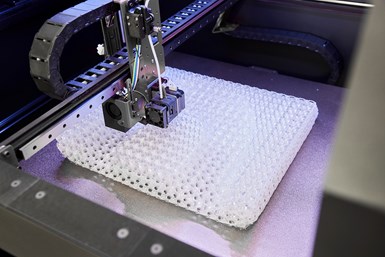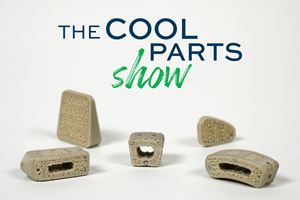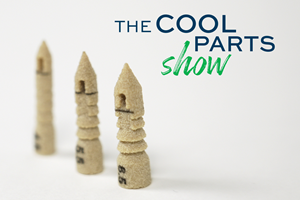Partners Improve Wheelchair Seats, Cushions Using 3D Printed Programmable Foam
The 3D printed programmable foam is said to enhance orthopedic seats and cushions, offering improved comfort and reliability for users.
The 3D printed programmable foam is said to enhance orthopedic seats and cushions, offering improved comfort and reliability for users. Photo Credit: Create it REAL
The Swiss company Leg&airy and Denmark-based Create it REAL are collaborating to enhance wheelchair seatings. Together, they plan to harness cutting-edge technology to manufacture 3D printed Programmable Foam for orthopedic seats and cushions to create a better quality of life for users.
“This partnership is more than just a substitution of conventional foam seating. It is a testament to our dedication to enhancing breathability, cleanliness and comfort,” says Faizan S. Mohammad, CEO and founder of Leg&airy. “Moreover, it symbolizes a stride into the future, adopting advanced manufacturing to guarantee that our seating solutions provide unparalleled comfort and dependability, regardless of the situation.”
The companies say this partnership combines the expertise of a technology pioneer and an orthopedic design powerhouse to pave the way for improving the seating experience for wheelchair users. It represents a fusion of diverse experiences that promise to deliver the best seating experience since the invention of foam.
The partners say they are leveraging cutting-edge 3D printed programmable foam technology to enhance orthopedic seats and cushions, offering improved comfort and reliability for users. This partnership brings together technological innovation and orthopedic design expertise to redefine the seating experience for wheelchair users worldwide.
Both Leg&airy and Create it REAL say they are enthusiastic about the potential of this partnership and eagerly anticipate the positive impact it will have on the lives of individuals seeking improved seating solutions.
Leg&airy says it is working to revolutionize the world of orthopedic devices, with a particular focus on digital fitting and design in the orthotics segment. It seeks to empower individuals by providing enhanced orthopedic devices that help ensure a life of freedom, dignity and limitless potential. It is also working toward a future where mobility limitations do not define one’s possibilities, and is committed to making this vision a reality through continuous innovation, dedication to quality and a passion for improving lives.
The project team has diverse backgrounds in health care, engineering, product design and manufacturing. It is focused on the unique challenges faced by individuals with mobility limitations, and is working to develop solutions that address these challenges and enhance overall well-being. From concept to creation, every product detail is carefully considered to ensure the highest level of comfort, functionality and durability, the company says. Also, it says it is not just creating orthopedic devices, it aims to redefine the future of mobility.
Create it REAL is a Danish company that says it enables creativity through 3D printing. The company has developed REALvision Core slicer technology, a cornerstone of its offerings. The company’s Embrace suite for orthopedic applications includes CAM solutions for insoles, corsets and seats, providing a range of opportunities for businesses in the health care sector seeking to mass customize high-quality products for individuals.
- Read about Bauer Hockey using EOS 3D printed digital foam for customizing helmets. The new in-store experience, combined with proprietary 3D printing technology, opens the door for personalized hockey products.
- Listen to this episode of AM Radio to learn about 3D printed lattice structures replacing foam components. On this episode of AM Radio, Stephanie Hendrixson and Julia Hider examine the use of 3D printed components with lattice structures to replace foams.
Related Content
FDA-Approved Spine Implant Made with PEEK: The Cool Parts Show #63
Curiteva now manufactures these cervical spine implants using an unusual 3D printing method: fused strand deposition. Learn how the process works and why it’s a good pairing with PEEK in this episode of The Cool Parts Show.
Read MoreUnderstanding PEKK and PEEK for 3D Printing: The Cool Parts Show Bonus
Both materials offer properties desirable for medical implants, among other applications. In this bonus episode, hear more from Oxford Performance Materials and Curiteva about how these companies are applying PEKK and PEEK, respectively.
Read MoreMore Affordable Suture Anchors 3D Printed from PEKK: The Cool Parts Show #60
Selective laser sintering (SLS) of polyether ketone ketone (PEKK) is being used to produce medical implants that are more cost effective and perform better than their conventional counterparts. We highlight fasteners known as suture anchors in this episode of The Cool Parts Show.
Read MoreFDA Approves 3D Systems’ Orthopedic Patient-Specific Guides for Ankle Replacements
The Total Ankle Patient-Matched Guides pair with Smith+Nephew’s Total Ankle replacement solutions and are designed to help surgeons save time and ensure accuracy while performing fewer steps than standard instrumentation.
Read MoreRead Next
Crushable Lattices: The Lightweight Structures That Will Protect an Interplanetary Payload
NASA uses laser powder bed fusion plus chemical etching to create the lattice forms engineered to keep Mars rocks safe during a crash landing on Earth.
Read MoreProfilometry-Based Indentation Plastometry (PIP) as an Alternative to Standard Tensile Testing
UK-based Plastometrex offers a benchtop testing device utilizing PIP to quickly and easily analyze the yield strength, tensile strength and uniform elongation of samples and even printed parts. The solution is particularly useful for additive manufacturing.
Read More3D Printed Polymer EOAT Increases Safety of Cobots
Contract manufacturer Anubis 3D applies polymer 3D printing processes to manufacture cobot tooling that is lightweight, smooth and safer for human interaction.
Read More





















